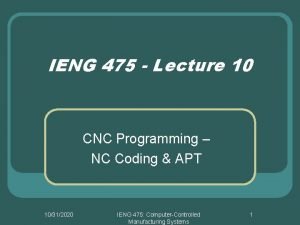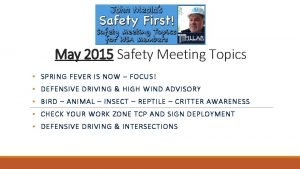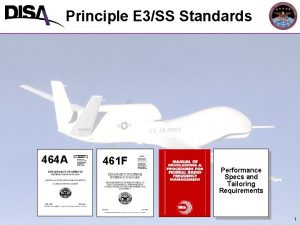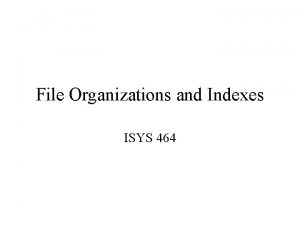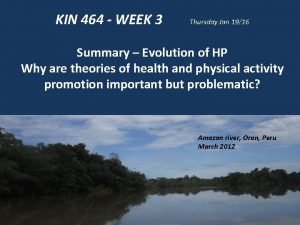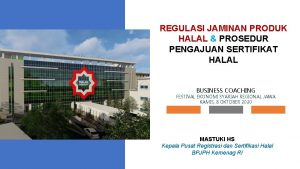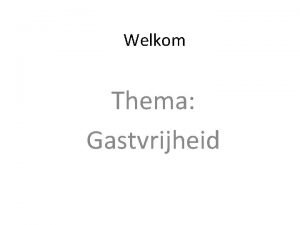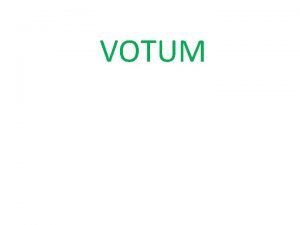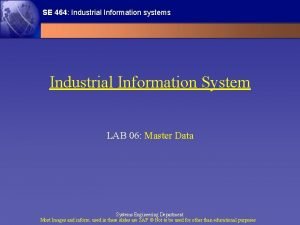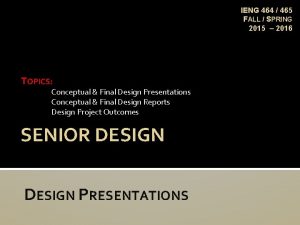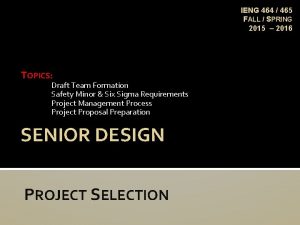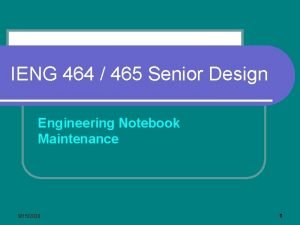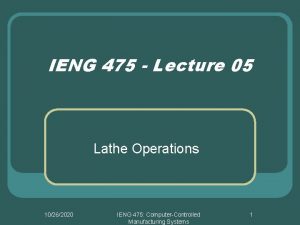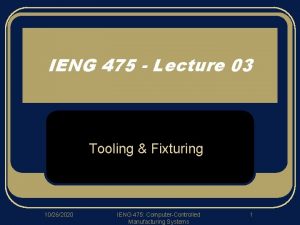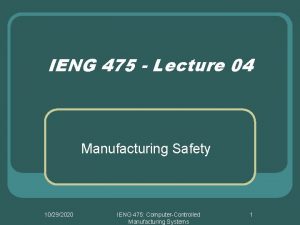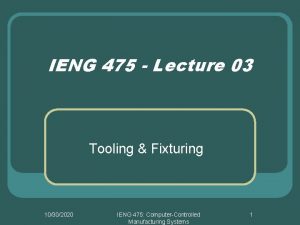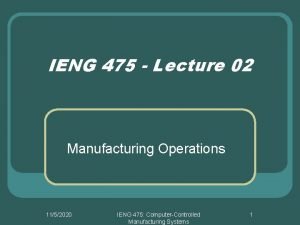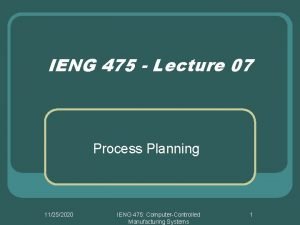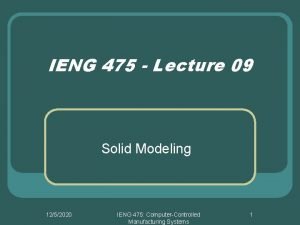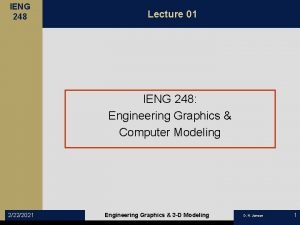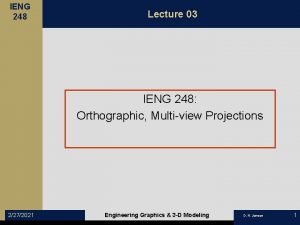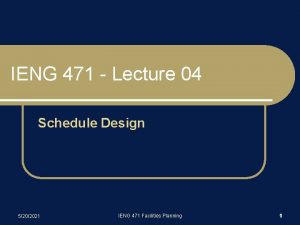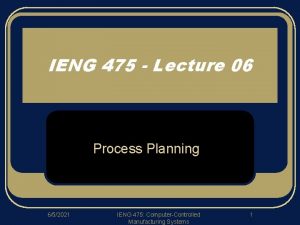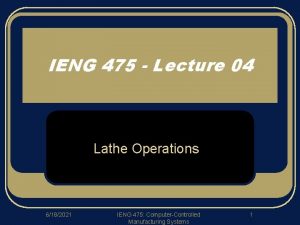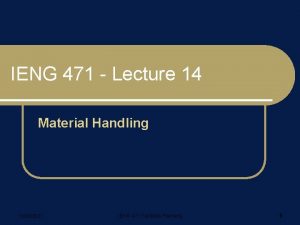IENG 464 465 FALL SPRING 2015 2016 TOPICS



















- Slides: 19

IENG 464 / 465 FALL / SPRING 2015 – 2016 TOPICS: Draft Team Formation Safety Minor & Six Sigma Requirements Project Management Process Project Proposal Preparation SENIOR DESIGN PROJECT SELECTION

DRAFT TEAM FORMATION �Get into desired project teams: One team per table group Ideally four people per team �Select a spokesperson: Prepare to provide: ▪ ▪ Project Title Project Sponsor Team Member Listing Brief Problem Description and Skills Required �Undecided persons should stay in the middle

SAFETY MINOR REQUIREMENTS � Significant Safety Content If anyone on your team is working on the Safety Minor, the project must have significant safety content The team member(s) working on the Safety Minor must work on that safety content � What to do: See Dr. Kerk or Dr. Piper ASAP ▪ Fill out the paperwork and turn in to Dr. Piper ▪ Do this in conjunction with your Proposal ▪ Do the design work ▪ Invite Dr. Piper or Dr. Kerk to the Conceptual Design Presentation ▪ Get Mid-Project Approval signature and feedback (adjust project accordingly) ▪ Do the implementation work ▪ Invite Dr. Piper or Dr. Kerk to the Final Results Presentation ▪ Get Final Project Approval signature, so you can … ▪ Graduate with a Safety Minor

SIX SIGMA CERTIFICATE REQUIREMENTS � Six Sigma Project (IENG 463) requirements: DMAIC process is used DURING the project Stand alone project report is submitted for a LETTER GRADE � Six Sigma Project Report: Report Structure: ▪ Cover Page ▪ Introduction & Problem Statement ▪ Headings for DMAIC Sections ▪ Recommendations, Conclusions and Acknowledgements ▪ References ▪ Appendices � Report is due at NOON on Last day of Finals Week

PROJECT MANAGEMENT PROCESS � IEEM Senior Design Projects address REAL problems: IEEM developed expertise is demonstrated DURING the project ▪ IEEM Project Rubric considers: Context, Analysis, Recommendations, and Communication ▪ ALL projects require management of the “triple constraint”: Time, Budget, and Function Result of each term is an earned LETTER GRADE � Senior Design Project Process: ▪ Draft Team Formation ▪ Individual Resumes ▪ Client-Team Meetings ▪ Engineering Project Proposal & Documentation ▪ Conceptual Design Development ▪ Progress Reporting ▪ Conceptual Design Presentation ▪ Design Development & Testing ▪ Progress Reporting ▪ Results Presentation ▪ Final Project Documentation � Final Documentation is due at NOON on Last day of Finals Week

IEEM PROJECT & PRESENTATION RUBRIC 3 2 1 0 Can identify both engineering and other environmental variables apropos to issue Root cause(s) of problem determined Wide range of appropriate evidence sources used Can identify engineering related environmental variables apropos to the issue Root cause(s) looked for, but process ended too soon Some appropriate evidence sources used Can identify environmental variables, but unsure which are related to the issue Multiple symptoms aggregated as problem Evidence sources used, but not entirely appropriate to issue Fails to identify environmental variables or see the need for these variables First symptom seen “defined” as the problem No or inappropriate evidence sources used Choose Appropriate Tools Both quantitative and qualitative tools used as appropriate Uses quantitative tools as appropriate Uses tools, but tools are not appropriate to issue No tools or frameworks used Develop a Chain of Evidence Clear links – uses data in its context and connects data using appropriate tools Links – uses data and connects using appropriate tools Almost links – based on inadequate data or tools No links – no chain of evidence Recommendation links to chain of evidence but comes from the “canned” set of alternatives Recommendation does not link to chain of evidence No recommendation made Make Choices Recommendation links to chain of evidence and shows consideration of additional alternatives Solution(s) considers implementation concerns and economic impact Solution(s) is technically feasible, but no additional concerns are considered Solution(s) is not feasible Reasonable Solutions Solution(s) considers implementation concerns, level of actual improvement, economic impact, social impact, and ethics Presentation of argument demonstrates problem definition, chain of evidence, analysis, and recommendation in easy to follow manner Well organized, uses professional language and grammar, appropriate use of tables, figures, etc, aimed at audience Presentation of argument demonstrates problem definition, chain of evidence, analysis, and recommendation but not easy to follow Somewhat organized, mostly uses professional language and grammar, appropriate use of tables, figures, etc, mostly aimed at audience Presentation of argument demonstrates only parts of: problem definition, chain of evidence, analysis, and recommendation Presentation of argument cannot be followed by reasonable audience member Somewhat organized, poor grammar, uses texting language, needed figures, tables, etc present and appropriate, not aimed at audience No organization, poor grammar, uses texting language, needed figures, tables, etc not present, not aimed at audience Context Account for Environmental Variables Define Problem Gather Evidence Analysis Recommendations Communication Clarity of Argument Professional Presentation

PROJECT PROPOSAL PREPARATION � Engineering Project Proposal Sections: ▪ Cover Page ▪ Executive Summary ▪ Introduction ▪ Problem Statement ▪ Constraints ▪ Scope of Work ▪ ▪ Deliverables Tasks Timing Budget ▪ Team Qualifications ▪ Team Members and Roles ▪ Summary of Team Qualifications ▪ Conclusions and Recommendations ▪ References ▪ Appendices � Hard copy of the Project Proposal is due at 5: 00 PM, 21 SEP, at RM 308

Team Composition � Team Size Limitations Teams can fire non-performers ▪ Must consult with Dr. Jensen to fire ▪ Means your team is a person smaller ▪ Means a fired person is going to have to work REAL hard to pass Ideal Team Size: ▪ ▪ Single discipline team: Multi-discipline team: Minimum team size: There is no team of size 1 4 persons 4 – 6 persons 3 persons (or 2, at least at the start of Sr. Design, anymore) Be wary of “waterfall” design models for “everything” ▪ Waterfall models have their place – some things cost $$$ ▪ Very few designs really can’t be prototyped inexpensively ▪ Avoid large projects that have leaders without strong project management skills especially if the waterfalls can’t be done concurrently! ▪ Avoid any project that doesn’t require every one to be responsible for progress reporting 10/26/2021 8

POTENTIAL DESIGN PROJECTS Starting Point for Forming Teams

Project Options �Multi-Disciplinary Must meet all requirements of IE and other depts �Multi-Year, Project Continuations Initial team leader will be the continuing student �Multi-Role, Single Discipline Client Proposed Projects of your own proposal

Multi-Disciplinary Project Options � Linked on Materials Page Rapid Response Casting System ME project listing CAMP projects Some EE/CPE projects may not be not on list Most CS projects are closed again this year � Big Question: Does SDSMT want to do multidisciplinary design? Requires students and departments to collaborate Meet everybody’s requirements Demonstrate measureable project success

LOW COST CNC ROUTER & GLOBAL SUPPLY CHAIN PROJECT � Lack of equipment for exploring CNC programming, process planning and general manufacturing engineering activities hinders STEM education in some cultures/lands � The goal of this project will be to identify, define, construct and demonstrate a small, expandable CNC Router and develop an inexpensive and effective supply chain for meeting the global technical education needs. � Considerations: Low cost system (approximately $1 000 USD or less) Open-source software and hardware Excellent construction documentation in multiple languages Development of small, low-cost products demonstrating basic operations Development of a global supply chain for sourcing the original equipment and replacement/expansion parts

CNC VERTICAL MILL WORKSTATION PROJECT � In order to fit the planned equipment for the Manufacturing/ Innovation Laboratory into the new, Library basement space, it will be necessary to redesign the CNC Vertical Mill workstation for a smaller footprint. � The current workstation has an approximate 8’ x 3’ footprint (without operator), is not ADA compliant, and has a horizontal layout. � The redesigned workstation should: Fit an approximate 4’ x 3’ footprint (without operator), using a more vertical layout Accommodate wheelchair access Demonstrate improved physical and cognitive ergonomics, both for operation and for assembly/relocation Considering improved guarding and safety of operation Be easily relocatable with respect to the laboratory location Be repeat ably relocatable with respect to the laboratory conveyor and robotic tending equipment.

BHW ERGONOMIC ADJUSTABLE EASEL KIT DESIGN COMPLETION PROJECT � Black Hills Works supports a number of clients with differing physical needs. There is a pressing need for a means to complete the existing redesign of an electrically adjustable easel to different heights and tilt angles. � The current design is functional, is powered by rechargeable drill battery, has an approximate 4’ x 3’ footprint (without operator), and is ADA compliant. However it needs optimization and process planning for BHW staff to reproduce and operate. � The redesigned easel will require: Optimal, final redesign/development for ergonomic operations, including ADA/wheelchair accessibility and safety. Completion of controls for configuration, based on solid physiological and ergonomic criteria, and appropriate to the identified client population. At least two iterations of purchase, construction, operational and usability testing of the retrofit kit(s) to meet customer constraints and needs prior to the Spring Design Fair. Proposal of a cost-effective system for kit production. Possible submission of the final design for NISH Competition.

CNC LATHE (TURNING CENTER) WORKSTATION PROJECT � In order to fit the planned equipment for the Manufacturing/ Innovation Laboratory into the new, Library basement space, it will be necessary to redesign the CNC Lathe workstation (called a TURNING CENTER) for a smaller footprint. � The current workstation has an approximate 6’ x 3’ footprint (without operator), is not ADA compliant, and has a horizontal layout. � The redesigned workstation should: Fit an approximate 4’ x 3’ footprint (without operator), using a more vertical layout Accommodate wheelchair access Demonstrate improved physical and cognitive ergonomics, both for operation and for assembly/relocation Considering improved guarding and safety of operation Be easily relocatable with respect to the laboratory location Be repeat ably relocatable with respect to the laboratory conveyor and robotic tending equipment.

3 -D PRINTING WORKSTATION PROJECT � At the end of the Spring Term in 2016, the Industrial Engineering Department will be moving into the basement floor of the SDSM&T Library. In order to fit the planned equipment for the Manufacturing/ Innovation Laboratory into the allocated space, it will be necessary to redesign the 3 -D Printing workstation for a smaller footprint. � The current equipment has five printers spread over a nearly 11’ x 2’ footprint (without operator), and has a horizontal layout. The equipment that must be accommodated includes the following: � Five Maker. Bot 3 -D Printers of various sizes At least one Fujitsu T 901 tablet computer and mouse Set of small drawers holding maintenance tools and materials Necessary hand tools for workstation operation and adjustment. The redesigned workstation should accommodate all the items and: Fit an approximate 6’ x 30” footprint (without operator), using a more vertical layout Accommodate wheelchair access Demonstrate improved physical and cognitive ergonomics, both for operation and for assembly/relocation Incorporate better filament storage and feeding operations Contain the appropriate electrical power systems Be easily relocatable with respect to the laboratory location Be expandable to incorporate existing 3 -D laser digitizer.

CNC ROUTER/CONVEYOR WORKSTATIONS PROJECT � In order to fit the planned equipment for the Manufacturing/ Innovation Laboratory into the new, Library space, it will be necessary to redesign the lab’s conveyor and add two or more CNC router workstations within the existing footprint. � The current workstation has an approximate 12’ x 8’ footprint (without operator or attaching workstations. ) This project will: Add two or more CNC Routers, each with an approximate 21” x 22” footprint (without operator), these should be constructed and re/dis-mountable for demonstrations Add a Scorbot ER V+ robot on a 56” x 10” linear slide for CNC Router tending operations Add a robotic controller for the ER V+ robot Add storage below the CNC Routers/Robot for standard book boxes of raw stock materials Demonstrate improved physical and cognitive ergonomics, both for operation and for assembly/relocation Be repeat-ably relocatable with respect to the laboratory CNC Vertical Mill/Lathe, AS/RS, and robotic tending equipment.

Stovetop Access � There a lot of products on the market geared toward preventing children from accessing stovetops, but these products become impractical for adults over 3 feet tall! � Many of the people we support require close supervision when the stove is in operation. � Problems results when the person independently accesses the stove or when the support staff has to step away to respond to an emergency. � This project is the completion of a design created last year. An interested team will need to view the existing design and Arrange for construction and testing of a full scale prototype Create detailed production plans for BHW staff to reproduce, including cost estimation Fully document the production and operation methods for the design. This project is available, but is not linked on the course Materials page. See instructor for existing documentation.

RC Central Concessions Overhaul � This project is necessary to create a sustainable model in which the concession stand is a benefit to the student athletes, the athletic department, and Central High School. The concession stand had failed to make a profit and, worse, in most years had ended in a deficit. This is a problem for the many student clubs, and organizations at Central High School whose primary fundraiser is working the concession stand. � In order to create a fully sustainable model, the project will involve planning, implementation, and assessment of both facility design and operations. Key considerations include: Assuring the new, sustainable model fits into the strategic plan of the athletics department and Central High School; Optimizing the layout of the concession stand area for safe operations by rotating crews of volunteers with little or no prior experience; Designing inventory, ordering, and budgeting systems that interact seamlessly with one another and require limited staff time to operate; and Developing both staff training and just-in-time training for concession stand volunteers that promotes a safe, effective workplace and considers the anticipated level of entering experience of the workers.
 5 letter words with i e n g
5 letter words with i e n g Winter spring summer autumn
Winter spring summer autumn Giduk
Giduk Spring safety meeting topics
Spring safety meeting topics Spring break 2015
Spring break 2015 Theme of things fall apart
Theme of things fall apart Thesis statement things fall apart
Thesis statement things fall apart Mil-std-464
Mil-std-464 Isys 464
Isys 464 Kin 464
Kin 464 Erd normalization
Erd normalization Sql certification microsoft
Sql certification microsoft Kma 464 tahun 2020
Kma 464 tahun 2020 Opwekking 464 tekst
Opwekking 464 tekst Cse 464
Cse 464 Kin 464
Kin 464 Isys 464
Isys 464 O heer my god lied 464
O heer my god lied 464 Industrial information system
Industrial information system Isys 464
Isys 464
